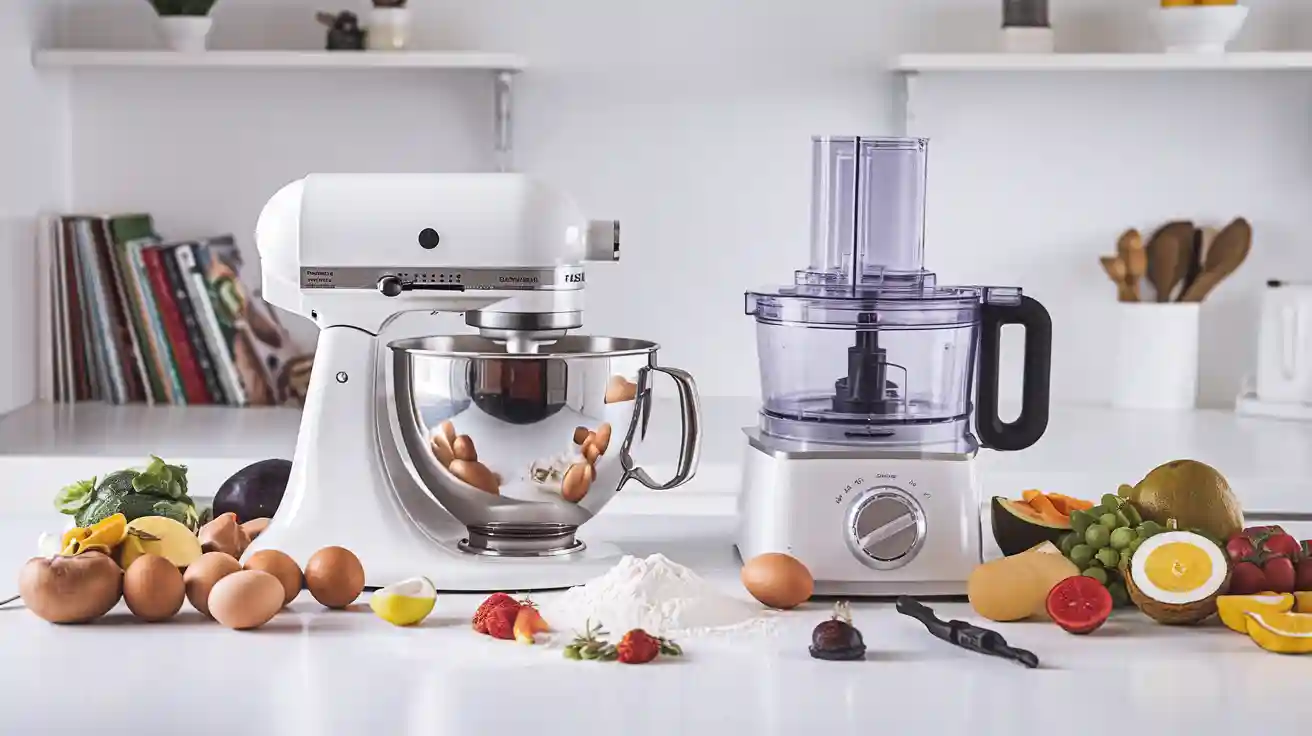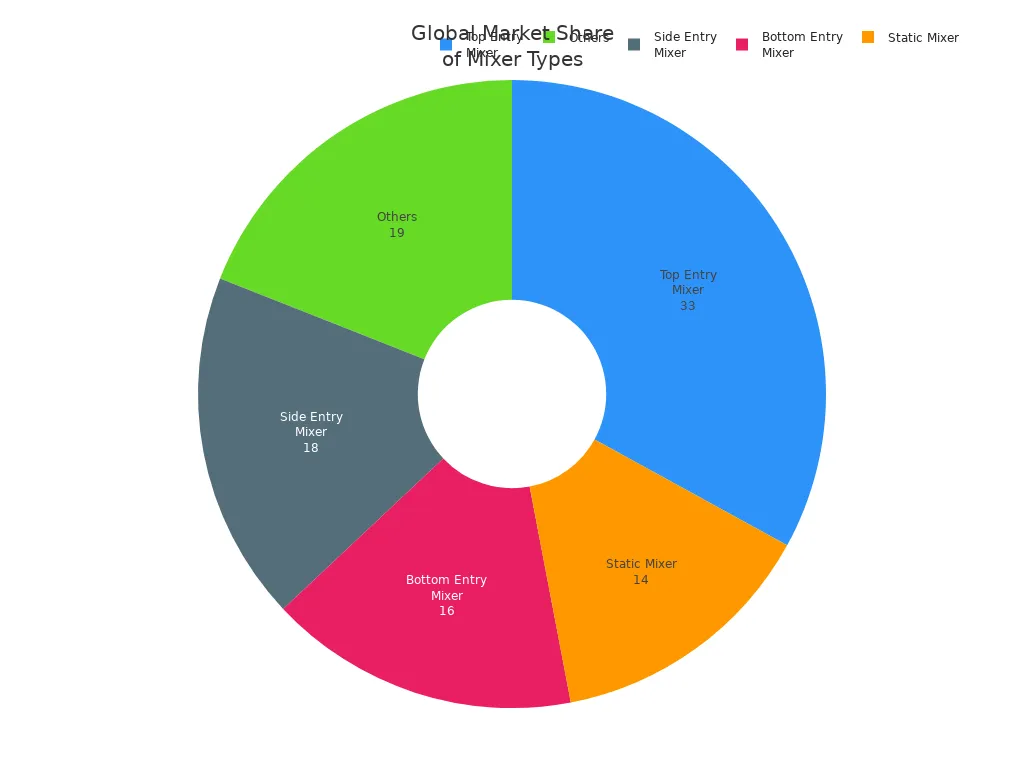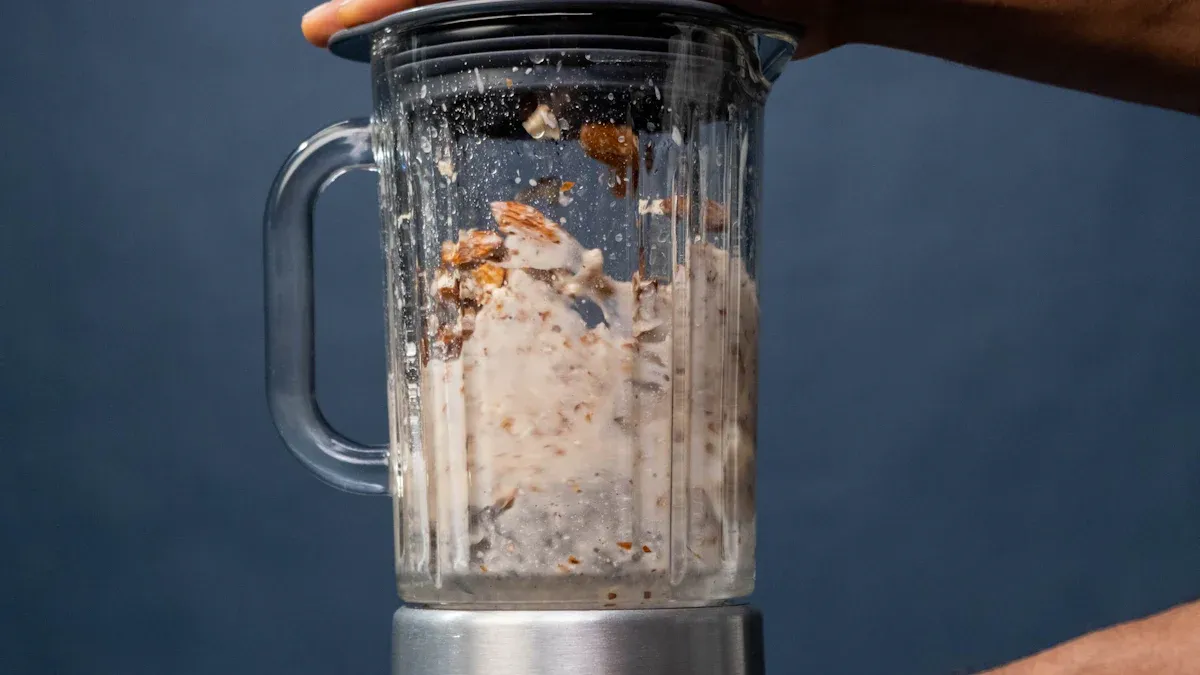
You might wonder when to reach for mixers food processors in your kitchen. If you need to chop veggies, shred cheese, or whip up dips fast, food processors shine. Mixers food processors also help with batters and dough, making your cooking smoother and more efficient.
- Food processors chop, mince, shred, and blend.
- Mixers handle dough and batters quickly.
Quick Reference: Mixers Food Processors at a Glance
Primary Uses of Mixers Food Processors
When you look at mixers food processors, you’ll notice each one shines in different areas. Mixers work best for baking tasks. You can use them to mix cake batter, knead bread dough, or whip cream. Stand mixers, like the ones you see on baking shows, use special agitators to combine ingredients smoothly. Many home bakers say they can’t imagine making cookies or cheesecakes without one.
Food processors, on the other hand, help you with meal prep by chopping, slicing, shredding, and pureeing. They come with different blades and discs, so you can quickly prepare veggies, make pastes, or even shred cheese. If you want to save time on chopping onions or making a smooth dip, a food processor is your go-to tool. Many families use both appliances to make cooking faster and easier, especially when preparing healthy meals at home.
Tip: If you love baking, a mixer is your best friend. If you want to speed up meal prep, a food processor will save you lots of time.
At-a-Glance Task Guide
Here’s a quick table to help you decide which appliance to use for common kitchen tasks:
| Task | Best Appliance | Why? |
|---|---|---|
| Mixing cake batter | Mixer | Even mixing, great for baking |
| Kneading bread dough | Mixer | Handles thick dough easily |
| Whipping cream/eggs | Mixer | Fast and fluffy results |
| Chopping vegetables | Food Processor | Quick, uniform cuts |
| Shredding cheese | Food Processor | Saves time, less mess |
| Making pastes/dips | Food Processor | Smooth texture, easy blending |
| Slicing fruits/veggies | Food Processor | Adjustable blades for perfect slices |
Mixers food processors both make cooking and meal prep easier, but each one has its own strengths. Choose the right tool for the job, and you’ll enjoy smoother, faster results in your kitchen.
Mixers Explained: Food Processor vs Mixer
Types of Mixers (Hand and Stand)
When you compare a food processor vs mixer, you’ll see two main types of mixers in most kitchens: hand mixers and stand mixers. Hand mixers are small, lightweight, and easy to store. You hold them while mixing, which gives you control over speed and direction. Stand mixers are bigger and sit on your counter. They have a bowl and different attachments, so you can knead, whip, or mix without holding anything. Stand mixers are especially popular for baking and kneading dough. The global stand mixer market keeps growing because people love their power and convenience.
Best Uses for Mixers
Mixers shine when you need to whip, beat, or knead. Here are the top three kitchen tasks where a mixer beats a food processor vs mixer every time:
- Whipping cream or eggs for fluffy desserts.
- Kneading dough for bread, pizza, or rolls.
- Beating butter and sugar for cookies or cakes.
You get perfectly mixed batters and doughs with less effort. Mixers help you achieve uniformly smooth results, which is key for baking success.
Strengths of Mixers
Mixers offer many features that boost your cooking efficiency. They handle large batches, save time, and reduce physical effort. You can multitask while your mixer works. Stand mixers have strong motors and special attachments, so you can knead cold butter or whip eggs with ease. These features help you make perfect doughs and consistent batters. Mixers also make cleanup simple since you usually only need to wash one bowl.
Tip: Mixers give you more control over mixing speed and texture, making them a favorite for anyone who loves baking.
Limitations of Mixers
Mixers do have limits when you look at food processor vs mixer. They focus on mixing, whipping, and kneading. You can’t use them for chopping, slicing, or shredding. Food processors come with more attachments for those tasks. Mixers have features like whisks and dough hooks, but they can’t cut or slice. If you want to prep veggies or shred cheese, you’ll need a food processor for better efficiency in your cooking routine.

Food Processors Explained: When to Use a Food Processor
Types of Food Processors
You can find many types of food processors in stores today. Some models are compact and fit small kitchens, while others have large bowls for big families. Here’s a quick table to help you compare popular options:
| Model & Brand | Capacity | Features & Notes | Price Indication |
|---|---|---|---|
| KitchenAid 7-Cup Food Processor | 7 cups | 3 speeds, easy to clean, accessories nest inside | Around $90 |
| Cuisinart Custom 14-Cup | 14 cups | Powerful motor, large feed tube | Mid-range |
| Hamilton Beach Stack and Snap Duo | 14 cups + 4 cups | Two bowl sizes, easy assembly | Reasonable |
| Breville Sous Chef 12-Cup | 12 cups | Premium features, multiple attachments | Around $350 |
You can choose a food processor based on your kitchen size, budget, and the tasks you want to do.
Best Uses for Food Processors
Wondering when to use a food processor? You’ll love it for meal prep. You can chop onions, slice carrots, or shred cheese in seconds. Many cooks use food processors to blend soups, puree dips, and even knead dough. Here are some top food processor uses:
- Chop vegetables, nuts, or herbs quickly
- Slice potatoes or fruits for salads
- Shred cheese, cabbage, or carrots for recipes
- Puree soups, sauces, or baby food
- Make breadcrumbs or grind spices
If you want to save time and boost efficiency, a food processor is a great choice for cooking.
Strengths of Food Processors
Food processors stand out for their versatility and efficiency. You can chop, slice, shred, and puree with just one machine. These features help you get even results every time. You’ll notice how much faster meal prep becomes. Many models come with different blades and attachments, so you can handle many tasks with ease. Food processors also help you control the quality and freshness of your ingredients. This makes cooking more fun and less stressful.
Tip: If you want to improve your efficiency in the kitchen, try using a food processor for shredding and slicing tasks.
Limitations of Food Processors
Every kitchen tool has pros and cons. Food processor pros and cons matter when you decide what to buy. Some users find food processors tricky because of all the blades and parts. You need to use them safely, since some models have had safety issues. Food processors use electricity, and parts can wear out over time. Sometimes, finding replacement parts is hard. Not all food processors last the same amount of time, so check reviews before you buy. Always follow the instructions to stay safe when you use a food processor.
Food Processor vs. Blender: Key Differences
When to Use a Food Processor vs. Blender
You might wonder about the real difference between a food processor and a blender. Both help you in the kitchen, but they work best for different jobs. A food processor handles solid foods. You can chop, slice, shred, or knead dough with it. The wide bowl and many blades make it easy to prepare veggies, cheese, or even dough for bread.
A blender, especially a high-powered blender, shines when you need to mix liquids. The tall pitcher and strong, fixed blade create a smooth texture. You can make smoothies, soups, or milkshakes in seconds. If you want the best for liquid-based ingredients, a high-quality blender gives you the smoothest results.
Here’s a quick table to help you see the main differences:
| Aspect | Food Processor | Blender |
|---|---|---|
| Bowl Shape | Wide, flat | Tall, narrow |
| Blades | Multiple, interchangeable | Single, fixed |
| Best For | Chopping, slicing, kneading dough | Smoothies, soups, sauces |
| Texture Output | Chopped, shredded, sliced | Smooth, pourable |
Tip: If you want to chop veggies or make dough, grab your food processor. For drinks or purees, reach for your blender.
Best Tasks for Each Appliance
You can save time and get better results by picking the right tool. The best tasks for a food processor include chopping onions, shredding cheese, slicing carrots, and making thick dips like hummus. You can also use it to knead dough for bread or pizza.
The best tasks for a blender focus on liquids. You can blend smoothies, soups, and sauces. A blender also works well for milkshakes and frozen drinks. If you want to crush ice or make a creamy soup, a blender does the job fast.
-
Use a food processor for:
- Chopping, slicing, and shredding veggies
- Making thick dips and spreads
- Kneading dough
-
Use a blender for:
- Smoothies and milkshakes
- Pureed soups and sauces
- Mixing drinks and crushing ice
Remember, the food processor vs. blender debate comes down to texture and ingredients. Food processors handle solid foods and give you control over texture. Blenders are best for smooth, liquid recipes.
Side-by-Side Comparison: Food Processor vs Mixer

Which Appliance for Which Task
Choosing between a food processor vs mixer can feel tricky, but you can make it simple by thinking about your menu and the tasks you do most. If you love baking bread or cakes, you’ll want a mixer for its strong kneading and mixing power. If you spend a lot of time chopping veggies or making dips, a food processor will save you loads of time.
Here’s how you can decide which appliance fits your kitchen best:
- Look at your favorite recipes. Do you bake more, or do you prep lots of veggies?
- Think about the main tasks you do. Do you need to chop, slice, or shred? Or do you need to whip, beat, and knead?
- Check your kitchen space. Mixers and food processors both take up room, but food processors are usually bulkier.
- Match the appliance to your cooking style. If you want fast meal prep, a food processor is your friend. If you want perfect cakes and bread, a mixer is the way to go.
- Make sure the appliance can handle the job. Some food processors can knead light dough, but mixers do better with heavy or sticky dough.
Tip: You don’t have to pick just one! Many home cooks use both a food processor and a mixer for different jobs.
When you compare a food processor vs mixer, you’ll notice that each one shines in different areas. Food processors handle slicing, chopping, grating, and puréeing with ease. They work best for thick, dry ingredients like raw veggies or chickpeas. Mixers, on the other hand, are champs at whipping cream, beating eggs, and kneading dough for bread or pizza.
Let’s break it down even more with a quick comparison:
- For bread making, mixers like the Bosch Universal or Ankarsrum Assistent give you gentle, even kneading and can handle big batches.
- For cake mixing, stand mixers such as the KitchenAid Professional 600 make smooth batters and fluffy frosting.
- For chopping vegetables or shredding cheese, a food processor is much faster and gives you even results.
You should also think about how easy each appliance is to use. Food processors often have more parts and can be noisy, but they finish prep jobs quickly. Mixers are quieter and easier to clean, but they don’t chop or slice unless you buy extra attachments.
Comparison Chart: Mixers Food Processors
Here’s a quick comparison to help you see the strengths of each appliance side by side:
| Task/Feature | Food Processor Performance | Mixer Performance |
|---|---|---|
| Dough Kneading | Fast for light doughs; can heat up dough; less gentle; may need hand finishing | Excellent for heavy doughs; gentle, consistent kneading; best for baking |
| Chopping/Slicing | Excels at chopping, slicing, shredding with S-blades and discs | Not designed for these tasks; needs special attachments |
| Whipping | Not suitable for whipping or creaming | Great for whipping cream, eggs, and mixing batters |
| Control & Consistency | Less control; can over-process; best for quick prep | More control; consistent results for delicate batters and dough |
| Attachments | Comes with blades/discs for cutting and shredding | Includes beaters, dough hooks, whisks; can add attachments for more uses |
| Batch Size | Handles small to medium batches; some models offer large bowls | Handles large batches; ideal for bakery-style tasks |
| Versatility | Great for chopping, grating, puréeing, and quick meal prep | Best for mixing, kneading, and whipping; can expand with attachments |
| Ease of Use | More parts to assemble and clean; can be noisy | Simple to use and clean; quieter operation |
| Size & Storage | Bulky and heavy; needs more storage space | Usually smaller; easier to store |
Note: Food processors are your go-to for quick comparison of meal prep tasks like chopping and slicing. Mixers win when you need perfect mixing or kneading for baking.
When you look at the food processor vs mixer debate, you’ll see that both appliances can make your kitchen life easier. Food processors give you speed and versatility for prep work, while mixers give you control and power for baking. If you want to save time and get the best results, think about your favorite dishes and pick the tool that matches your needs.
Choosing the Right Appliance for Your Kitchen
Assessing Your Cooking Habits
When you start choosing the right appliance, think about how you cook every day. Ask yourself a few questions to help you decide:
- How often do you cook at home?
- What types of meals do you make most—baking, salads, or big family dinners?
- Do you like trying new recipes or sticking to your favorites?
- How many people do you usually cook for?
- Do you want quick meal prep or do you enjoy spending time in the kitchen?
- Are you looking for easy-to-use controls and simple cleaning?
- Do you care about saving energy or picking eco-friendly options?
- Have you checked reviews to see what other cooks like you recommend?
These questions help you match your habits with the best kitchen tools.
Considering Kitchen Space and Budget
Your kitchen space and budget play a big part in choosing the right appliance. Here are some things to keep in mind:
- Small kitchens work better with compact or cordless models that are easy to store.
- Large, powerful appliances need more counter space and a dedicated outlet.
- Cordless food processors cost less but may not handle big jobs.
- Corded models cost more but work better for heavy-duty tasks.
- Mixers come in different sizes. Some take up less space but may not handle large batches.
- If you have a tight budget, look for versatile appliances that can do more than one job.
Tip: Measure your counter and storage space before you buy. This helps you avoid surprises!
Do You Need Both Mixers Food Processors?
You might wonder if owning both a mixer and a food processor makes sense. Here’s a quick look at the benefits and drawbacks:
| Aspect | Food Processor (Pros/Cons) | Mixer (Pros/Cons) |
|---|---|---|
| Versatility | Chops, slices, shreds, purees, kneads light dough / Bulky | Mixes, whips, kneads heavy dough / Not for chopping |
| Efficiency | Fast meal prep / Can be noisy | Hands-free mixing / Needs cleaning |
| Ease of Use | Simple controls / Many parts to clean | Easy controls / Attachments need cleaning |
| Cost | Worth it for versatility / High-end models are pricey | Durable / Can be expensive |
| Space | Needs storage space | Some models are compact |
Having both appliances gives you more options and makes your kitchen ready for any recipe. Just remember to balance space, cost, and how much you’ll use each one.
You want the right tool for the job. Check out this quick guide:
| Use Most For | Pick a Food Processor | Pick a Mixer |
|---|---|---|
| Chopping, slicing | ✅ | |
| Baking, dough, mixing | ✅ |
Think about your habits, space, and cleaning needs. Trust reliable brands for long-lasting satisfaction. Choose what fits your kitchen best!
FAQ
Can I use a food processor to knead bread dough?
You can knead light bread dough in a food processor. For heavy or sticky dough, a stand mixer works better and gives you smoother results.
Do mixers and food processors need a lot of cleaning?
Mixers usually have fewer parts to clean. Food processors have more blades and bowls, so you spend a bit more time washing them.
Which appliance should I buy first for a small kitchen?
If you bake often, start with a mixer. If you prep lots of veggies or want quick chopping, a food processor saves you more time.


